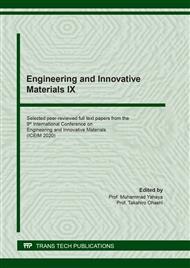[1]
B. Doshi, M. Sillanpää and S. Kalliola: Water Research Vol. 135 (2018), p.262–277.
Google Scholar
[2]
C. Teas, S. Kalligeros, F. Zanikos, S. Stournas, E. Lois, and G. Anastopoulos: Desalination Vol. 140 (2001), p.259–264.
DOI: 10.1016/s0011-9164(01)00375-7
Google Scholar
[3]
O. Ifelebuegu and A. Johnson: Critical Reviews in Environmental Science and Technology Vol. 47 (2017), p.964–1001.
Google Scholar
[4]
A. Tuan Hoang, V. Viet Pham, and D. Nam Nguyen: Int. J. Appl. Eng. Res. Vol. 13 (2018), p.4915–4928.
Google Scholar
[5]
H. Maleki: Chem. Eng. J. Vol. 300 (2016), p.98–118.
Google Scholar
[6]
J. Rong, T. Zhang, F. Qiu, J. Xu, Y. Zhu, D. Yang, and Y. Dai: Mater. Des. Vol. 142 (2018), p.83–92.
Google Scholar
[7]
F. Zhang, W. Bin Zhang, Z. Shi, D. Wang, J. Jin, and L. Jiang: Adv. Mater., Vol. 25 (2013), p.4192–4198.
Google Scholar
[8]
X. Zhou, Z. Zhang, X. Xu, F. Guo, X. Zhu, X. Men, and B. Ge: ACS Appl. Mater. Interfaces Vol. 5 (2013) no. 15, p.7208–7214.
DOI: 10.1021/am4015346
Google Scholar
[9]
V. Singh, R. J. Kendall, K. Hake, and S. Ramkumar: Industrial and Engineering Chemistry Research Vol. 52 (2013), p.6277–6281.
Google Scholar
[10]
X. Zhang, C. Wang, W. Chai, X. Liu, Y. Xu, and S. Zhou: Journal of Chemical Technology and Biotechnology Vol. 92 (2017), p.1613–1619.
Google Scholar
[11]
M. U. Herrera, C. M. Futalan, R. Gapusan, and M. D. L. Balela: submitted to Water Science and Technology (2018).
Google Scholar
[12]
R. Agcaoili, M. U. Herrera, C. M. Futalan, and M. D. L. Balela: Journal of the Taiwan Institute of Chemical Engineers Vol. 78 (2017), p.359–369.
DOI: 10.1016/j.jtice.2017.06.038
Google Scholar
[13]
X. F. Sun, R. Sun, and J. X. Sun: Journal of Agricultural and Food Chemistry Vol. 50 (2002), p.6428–6433.
Google Scholar
[14]
S. F. S. Draman, R. Daik, F. A. Latif, and S. M. El-Sheikh: BioResources Vol. 9 (2014), p.8–23.
Google Scholar
[15]
M. A. Abdullah, A. U. Rahmah, and Z. Man: Journal of Hazardous Materials Vol. 177 (2010), p.683–691.
Google Scholar
[16]
J. Wang, Y. Zheng, and A. Wang: Chemical Engineering Journal Vol. 213 (2012), p.1–7.
Google Scholar
[17]
R. S. Rengasamy, D. Das, and C. Praba Karan: Journal of Hazardous Materials Vol. 186 (2011), p.526–532.
Google Scholar
[18]
S. Meiwu, X. Hong, and Y. Weidong: Res. J. Vol. 80 (2010), p.159–165.
Google Scholar
[19]
S. D. Tigno, M. U. Herrera, and M. D. L. Balela: Surface and Coatings Technology Vol. 350 (2018), p.857–862.
DOI: 10.1016/j.surfcoat.2018.04.017
Google Scholar
[20]
J. Wang, Y. Zheng, Y. Kang, and A. Wang: Chemical Engineering Journal Vol. 223 (2013), p.632–637.
Google Scholar
[21]
D. Lu, Z. Mo, B. Liang, L. Yang, Z. He, H. Zhu, Z. Tang, X. Gui,: Carbon Vol. 133 (2018), p.457–463.
Google Scholar
[22]
R. B. Gapusan and M. D. L. Balela: submitted to Materials Chemistry and Physics (2020).
Google Scholar
[23]
J. Wang, Y. Zheng, and A. Wang: Industrial Crops and Products Vol. 40 (2012), p.178–184.
Google Scholar
[24]
H. Yang, R. Yan, H. Chen, D. H. Lee, and C. Zheng: Fuel Vol. 86 (2007), p.1781–1788.
Google Scholar
[25]
K. Werner, L. Pommer, and M. Broström: Journal of Analytical and Applied Pyrolysis Vol. 110 (2014), p.130–137.
Google Scholar
[26]
M. Brebu and C. Vasile: Cellulose Chem. Technol. Vol. 44 (2010), p.353–363.
Google Scholar
[27]
K. Cheng, W. T. Winter, and A. J. Stipanovic: Polym. Degrad. Stab. Vol. 97 (2012), p.1606–1615.
Google Scholar
[28]
G. Dorez, L. Ferry, R. Sonnier, A. Taguet, and J. M. Lopez-Cuesta: J. Anal. Appl. Pyrolysis Vol. 107 (2014), p.323–331.
DOI: 10.1016/j.jaap.2014.03.017
Google Scholar
[29]
M. Fan, D. Dai, and B. Huang: Fourier Transform - Mater. Anal. (2012).
Google Scholar
[30]
Y. Cao et al.: Sustainable Energy and Fuels Vol. 2 (2018), p.455–465.
Google Scholar


